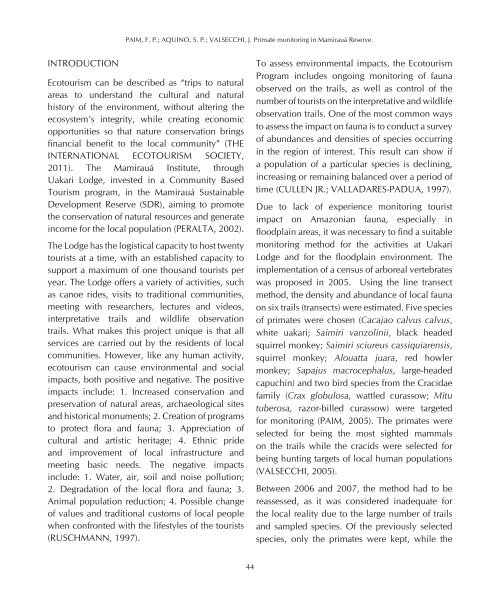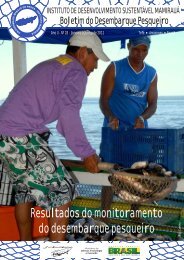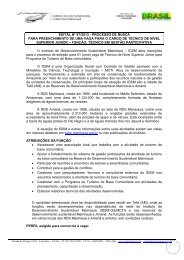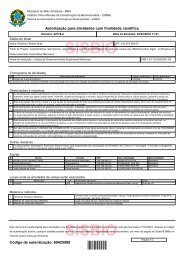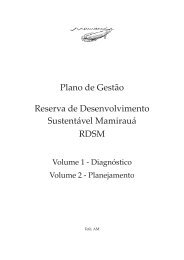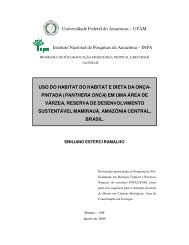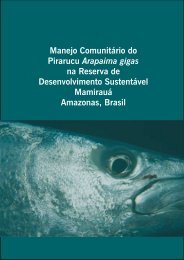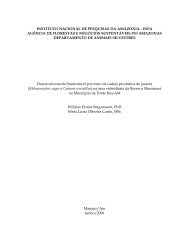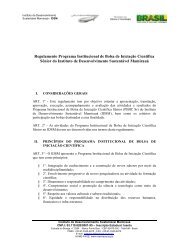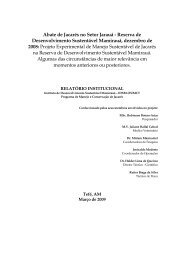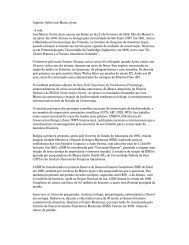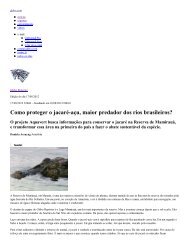UAKARI - Instituto de Desenvolvimento Sustentável Mamirauá
UAKARI - Instituto de Desenvolvimento Sustentável Mamirauá
UAKARI - Instituto de Desenvolvimento Sustentável Mamirauá
- No tags were found...
Create successful ePaper yourself
Turn your PDF publications into a flip-book with our unique Google optimized e-Paper software.
PAIM, F. P.; AQUINO, S. P.; VALSECCHI, J. Primate monitoring in Mamirauá Reserve.INTRODUCTIONEcotourism can be <strong>de</strong>scribed as “trips to naturalareas to un<strong>de</strong>rstand the cultural and naturalhistory of the environment, without altering theecosystem’s integrity, while creating economicopportunities so that nature conservation bringsfinancial benefit to the local community” (THEINTERNATIONAL ECOTOURISM SOCIETY,2011). The Mamirauá Institute, throughUakari Lodge, invested in a Community BasedTourism program, in the Mamirauá SustainableDevelopment Reserve (SDR), aiming to promotethe conservation of natural resources and generateincome for the local population (PERALTA, 2002).The Lodge has the logistical capacity to host twentytourists at a time, with an established capacity tosupport a maximum of one thousand tourists peryear. The Lodge offers a variety of activities, suchas canoe ri<strong>de</strong>s, visits to traditional communities,meeting with researchers, lectures and vi<strong>de</strong>os,interpretative trails and wildlife observationtrails. What makes this project unique is that allservices are carried out by the resi<strong>de</strong>nts of localcommunities. However, like any human activity,ecotourism can cause environmental and socialimpacts, both positive and negative. The positiveimpacts inclu<strong>de</strong>: 1. Increased conservation andpreservation of natural areas, archaeological sitesand historical monuments; 2. Creation of programsto protect flora and fauna; 3. Appreciation ofcultural and artistic heritage; 4. Ethnic pri<strong>de</strong>and improvement of local infrastructure andmeeting basic needs. The negative impactsinclu<strong>de</strong>: 1. Water, air, soil and noise pollution;2. Degradation of the local flora and fauna; 3.Animal population reduction; 4. Possible changeof values and traditional customs of local peoplewhen confronted with the lifestyles of the tourists(RUSCHMANN, 1997).To assess environmental impacts, the EcotourismProgram inclu<strong>de</strong>s ongoing monitoring of faunaobserved on the trails, as well as control of thenumber of tourists on the interpretative and wildlifeobservation trails. One of the most common waysto assess the impact on fauna is to conduct a surveyof abundances and <strong>de</strong>nsities of species occurringin the region of interest. This result can show ifa population of a particular species is <strong>de</strong>clining,increasing or remaining balanced over a period oftime (CULLEN JR.; VALLADARES-PADUA, 1997).Due to lack of experience monitoring touristimpact on Amazonian fauna, especially infloodplain areas, it was necessary to find a suitablemonitoring method for the activities at UakariLodge and for the floodplain environment. Theimplementation of a census of arboreal vertebrateswas proposed in 2005. Using the line transectmethod, the <strong>de</strong>nsity and abundance of local faunaon six trails (transects) were estimated. Five speciesof primates were chosen (Cacajao calvus calvus,white uakari; Saimiri vanzolinii, black hea<strong>de</strong>dsquirrel monkey; Saimiri sciureus cassiquiarensis,squirrel monkey; Alouatta juara, red howlermonkey; Sapajus macrocephalus, large-hea<strong>de</strong>dcapuchin) and two bird species from the Cracidaefamily (Crax globulosa, wattled curassow; Mitutuberosa, razor-billed curassow) were targetedfor monitoring (PAIM, 2005). The primates wereselected for being the most sighted mammalson the trails while the cracids were selected forbeing hunting targets of local human populations(VALSECCHI, 2005).Between 2006 and 2007, the method had to bereassessed, as it was consi<strong>de</strong>red ina<strong>de</strong>quate forthe local reality due to the large number of trailsand sampled species. Of the previously selectedspecies, only the primates were kept, while the44


